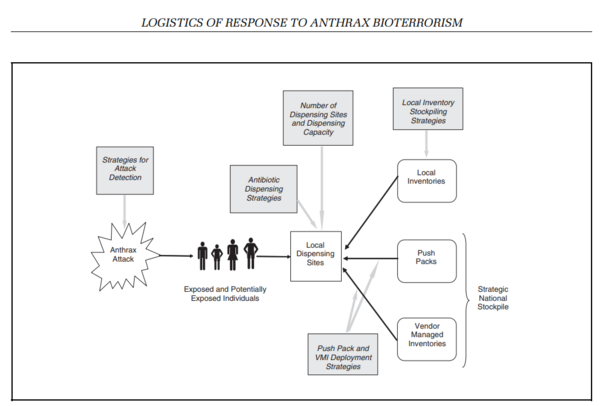Smallpox and Anthrax as Agents of Bioterrorism
Introduction to Bioterrorism

By Emily Rogers
Bioterrorism is defined as using “using biological agents to inflict disease and/ or death on humans, animals or plants, and motivations for pursuing such an attack could have religious, political, or criminal motivations.”[1] People that plan and perform bioterrorism attacks could also be a part of nationalist, separatist, or apocalyptic cult groups.[2] Biological agents can also be used by military and government agencies in warfare.[2] Early records of bioterrorism in the 14th century include the Tartar group attacking the city Kaffa by catapulting cadavers infected with the plague, caused by the bacteria Yersinia pestis, over the walls of the city, causing the plague to spread over the Mediterranean.[2] More recently in 1984, a cult following the Rajneeshee movement poisoned a restaurant in Oregon with Salmonella bacteria because they had political motives to win an election.[2] Unlike other types of terror attacks, bioterrorism has the unique ability to go undetected for a severe length of time, in which infected individuals can spread the agent even further, before the attack event is even detected.[2]Starting in 2001 and last reviewed in 2018, the Centers for Disease Control and Prevention (CDC) has published a list of the most dangerous infectious agents that could be used for bioterrorism acts.[3]
The insertion code consists of:
Double brackets: [[
Filename: PHIL_1181_lores.jpg
Thumbnail status: |thumb|
Pixel size: |300px|
Placement on page: |right|
Legend/credit: Electron micrograph of the Ebola Zaire virus. This was the first photo ever taken of the virus, on 10/13/1976. By Dr. F.A. Murphy, now at U.C. Davis, then at the CDC. Every image requires a link to the source.
Closed double brackets: ]]
Other examples:
Bold
Italic
Subscript: H2O
Superscript: Fe3+
Overview of Smallpox
Variola major is the virus that causes smallpox.[1]

The Virus
Variola major is the virus that causes smallpox.[4] Symptoms of smallpox include fever and the characteristic skin rash of pox, and it has a 30% mortality rate.[4] The mortality rate of smallpox for pregnant females was very high, up to 70% for those unvaccinated.[4] Ocular variola and resulting blindness was common in smallpox patients in Asia.[4] Smallpox in children caused elbow and knee joint problems in around 2% of unvaccinated children.[4] Those who survived having smallpox were left with many scars on their body.[4]
History
Variola virus emerged thousands of years ago and has subsequently infected many human populations throughout history, causing epidemics of smallpox.[4] The oldest description of smallpox came from China in the 4th century CE. Remnants of smallpox pustules have been found on Egyptian mummies that were 3,000 years old.[4] It is theorized that trade and exploration contributed to the spread of smallpox.[4] Variolation was an early method for control of smallpox, invented by Edward Jenner in 1796 when he took matter from a pustule of a person infected with cowpox and inoculated another person with it.[4] Jenner exposed the inoculated person to variola virus and they did not get sick, confirming Jenner’s theory that exposure to cowpox could prevent a person from getting smallpox.[4] The ideas from his research lead to the first vaccination in the 1800’s.[4]
Eradication
Starting in 1959, the World Health Organization (WHO) initiated a design to eradicate smallpox from the world.[4] The last naturally occurring outbreak of smallpox in the United States happened in 1949, and by 1966 smallpox was still prevalent in outbreaks on the continents of Asia, Africa and South America.[4] After 1966, new developments contributed to the eradication cause, like the use of the bifurcated needle, higher quality freeze-dried vaccine, and campaigns for more vaccination.[4] By 1980, the World Health Assembly declared smallpox eradicated from earth.[4] After eradication, it was determined by health officials that research should still be done on variola virus.[4]
Research to Prepare for Bioterrorism
Smallpox as a Bioterrorism Agent
History
According to the CDC, smallpox is labeled as one of the most dangerous potential agents of bioterrorism in the world.[3] It earns this title because of the agent's ease of transmission, the world population's lack of immunity, and the speed of spread from one infected person to another.[5]
Population immunity
The world population's lack of immunity to smallpox is due to the fact that anyone born after the 1970’s will not have been vaccinated because most countries stopped providing the vaccine after the virus was eradicated from Earth.[6]
Research
After smallpox eradication from the natural world, there was debate whether the remaining Variola virus in controlled laboratory environments should be destroyed completely, or should be kept alive for further research on smallpox disease.[7] Since smallpox in the natural world was destroyed before it had the chance to be studied in a modern clinal setting, the World Health Organization (WHO) in 1999 allowed research on Variola major to happen under a WHO committee.[7] The problems the researchers were addressing were a lack of understanding the pathophysiology of the smallpox disease, a lack of an adequate animal model system to study the virus, a need to improve function of laboratory tests, a lack of an antiviral drug to work against Variola major, and lack of knowledge about the overall genetic makeup of the virus.[7] There are currently two known places on Earth where variola virus is stored and researched: the Centers for Disease Control and Prevention in Atlanta Georgia USA, and the State Research Center of Virology and Biotechnology in Koltsovo Russia.[7] Since 1999, many clinical questions about smallpox have in fact been answered and thus there is controversy whether the variola virus stored and researched in these labs should be destroyed, or should be continued to be studied.[7]
Anthrax
The Bacterium
Bacillus anthracis is the bacterium that causes anthrax disease.[8] The bacterium is gram-positive, rod-shaped, and spore-forming.[8] B. anthracis is naturally found in the soil, and anthrax is spread to animals that graze and ingest the spores.[8] The spores have a protective coating that makes them immune to environmental factors and host defenses.[8] Anthrax can infect the body by getting into cuts, being ingested or being inhaled, and spores being inhaled has been determined to be the most likely form of distribution that would be in a bioterror attack.
History
It is believed that anthrax has ancient origins in Egypt, Mesopotamia and Greece.[9] Ancient depictions lead scholars to think that anthrax might be written about in the Bible as the fifth plague of Egypt, and also in the Iliad by Homer.[9]
Scientist Louis Pasteur created the first anthrax vaccine in 1881. In 1979 the former Soviet Union experienced an accidental release of anthrax aerosols that caused an epidemic. The anthrax aerosol traveled up to 50 km and killed around 60 people and many livestock animals, proving that the released spores can have a significant impact.
In fact, very soon after the terrorist attack in the United States on September 11th 2001, the country experienced another terror attack, in the form of Bacillus anthracis spores being sent in the mail. This event caused 22 cases of anthrax and 5 deaths.
Modern anthrax vaccines have been more successful if they contain a combination of plasmid DNA that encodes for important outer proteins PA and BclA, than those vaccines that only contain plasmids for one of these proteins.[8]
Bioterrorism
Anthrax spores are consistently labeled a leading bioweapon threat due to their ease of dispersal and their stability. Anthrax spores infect the body by being inhaled into the lungs and being transported throughout the alveolar spaces. There have been independent terrorist groups that threaten to use anthrax spores as a bioterrorism agent. Additionally, biological weapons programs in Iraq and the former Soviet Union have been known to study delivery of pathogenic aerosols by aircraft, including anthrax aerosols. Many systems have been put into place to detect the first cases of anthrax or another illness due to a potential bioterrorism attack. The Department of Health and Human Services (DHHS) provided over 918 million dollars to state and local health departments to assist their preparations for terrorist attacks. At the time of the Anthrax attacks, the Laboratory Response Network for Bioterrorism (LRN) tested about one million environmental specimens. Since then, because of the success and importance of these laboratories, more specialty LRN laboratories have been created in the United States, and they now have the capacity to test for microbes that cause anthrax, botulism, tularemia, and plague in the event of a bioterrorist attack.

Response to Bioterrorism
Because of the apparent risk anthrax poses as a potential agent of bioterrorism, there have been extensive procedures published, preparing for an attack on the United States, with the goal of creating a logistic mathematical model for the allocation and timely distribution of medical supplies.[10] There are three organizational levels of funds and supplies, and those are the national, regional and local levels.[10] It is imperative that first responders, elected officials and medical personnel from all three levels work in line with the plan in order to work efficiently in the event of a bioterrorism attack.[10] In the United States, stockpiles of supplies such as antibiotics and antidotes for many possible bioterrorism agents are held at the national level at the Strategic National Stockpile.[10] These supplies are called “push packs” and can be distributed to any local community at the time of a bioterrorism attack.[10] In addition to these nationally held push packs are “Vendor Managed Inventories” of supplies held at the regional or state level which can be distributed at the local level in the event that the national stockpile needs assistance.[10]
A study done, led by Gregory Zaric at the University of Western Ontario, Canada, aimed to model the preparedness of communities to an anthrax bioterrorism attack.[10] This study summarizes a mathematical model used in Excel to attempt to answer situational questions, and help inform local community leaders what the facts are about preparedness, and offers insight to how funds should be allocated to maximize preparedness.[10]
Next
Conclusion
References
- ↑ 1.0 1.1 Klietmann, W., & Ruoff, K. (2001). Bioterrorism: Implications for the Clinical Microbiologist. Clinical Microbiology Reviews, 14(2).
- ↑ 2.0 2.1 2.2 2.3 2.4 Poupard J. A. and Miller L. A. History of biological warfare: catapults to capsomeres. Ann. N.Y. Acad. Sci. 666 1992 9 -20
- ↑ 3.0 3.1 Bioterrorism agents/ diseases. (2018, April 4). Centers for Disease Control and Prevention. Retrieved April 14, 2023, from https://emergency.cdc.gov/agent/agentlist-category.asp#catdef
- ↑ 4.00 4.01 4.02 4.03 4.04 4.05 4.06 4.07 4.08 4.09 4.10 4.11 4.12 4.13 4.14 4.15 4.16 History of smallpox. (2017, July 12). Centers for Disease Control and Prevention. Retrieved April 15, 2023, from https://www.cdc.gov/smallpox/history/history.html
- ↑ [https://www.sciencedirect.com/science/article/abs/pii/S016635420200195X?casa_token=BAEEGzZOu1QAAAAA:jxDQksNJlx34KwNixNQR0UV6v2aAMlqQRAzTNSdddhULo97VugZPdM6YqsVLmW8w00j6Fq-DwQ Whitley, R. (2003). Smallpox: a potential agent of bioterrorism. Science Direct, 57(1-2). ]
- ↑ Cohen, J. (2001). Smallpox Vaccinations: How Much Protection Remains? American Association for the Advancement of Science, 294(5544).
- ↑ 7.0 7.1 7.2 7.3 7.4 Lane, J. M. (2011). Remaining Questions about Clinical Variola Major. Emerging Infectious Diseases, 17(4).
- ↑ 8.0 8.1 8.2 8.3 8.4 Bouzianas, D. (2009). Medical countermeasures to protect humans from anthrax bioterrorism. Science Direct, 17(12).
- ↑ 9.0 9.1 [https://www.cdc.gov/anthrax/basics/anthrax-history.html History of Anthrax. (2020, November 20). Centers for Disease Control and Prevention. Retrieved April 15, 2023, from https://www.cdc.gov/anthrax/basics/anthrax-history.html]
- ↑ 10.0 10.1 10.2 10.3 10.4 10.5 10.6 10.7 Zaric, G., Bravata, D., Cleophas Holty, J.-E., McDonald, K., Owens, D., & Brandeau, M. (2008). Modeling the Logistics of Response to Anthrax Bioterrorism. Medical Decision Making.
Authored for BIOL 238 Microbiology, taught by Joan Slonczewski, 2023, Kenyon College
